Management and Organisations in a Global Environment: Ford and Taylor
VerifiedAdded on 2020/03/04
|6
|1337
|248
Report
AI Summary
This report delves into two key areas: Ford and Taylor's scientific management and Thomas Friedman's three eras of globalization. The first part examines the Ford Motor Company's labor issues and the innovative solutions implemented by Ford, often in collaboration with Taylor, including the introduction of the conveyor belt system to enhance production efficiency and increase worker productivity. The report highlights the impact of these management techniques on the workforce, including increased wages and the suppression of trade unions. The second part of the report explores Thomas Friedman's framework for understanding globalization, categorizing it into three distinct eras: Globalization 1.0 (country globalization), Globalization 2.0 (company globalization), and Globalization 3.0 (individual globalization). Each era is characterized by different driving forces and levels of interconnectedness. The report also mentions Friedman's 'ten flatteners' of the global world and their impact on the structure of the world.
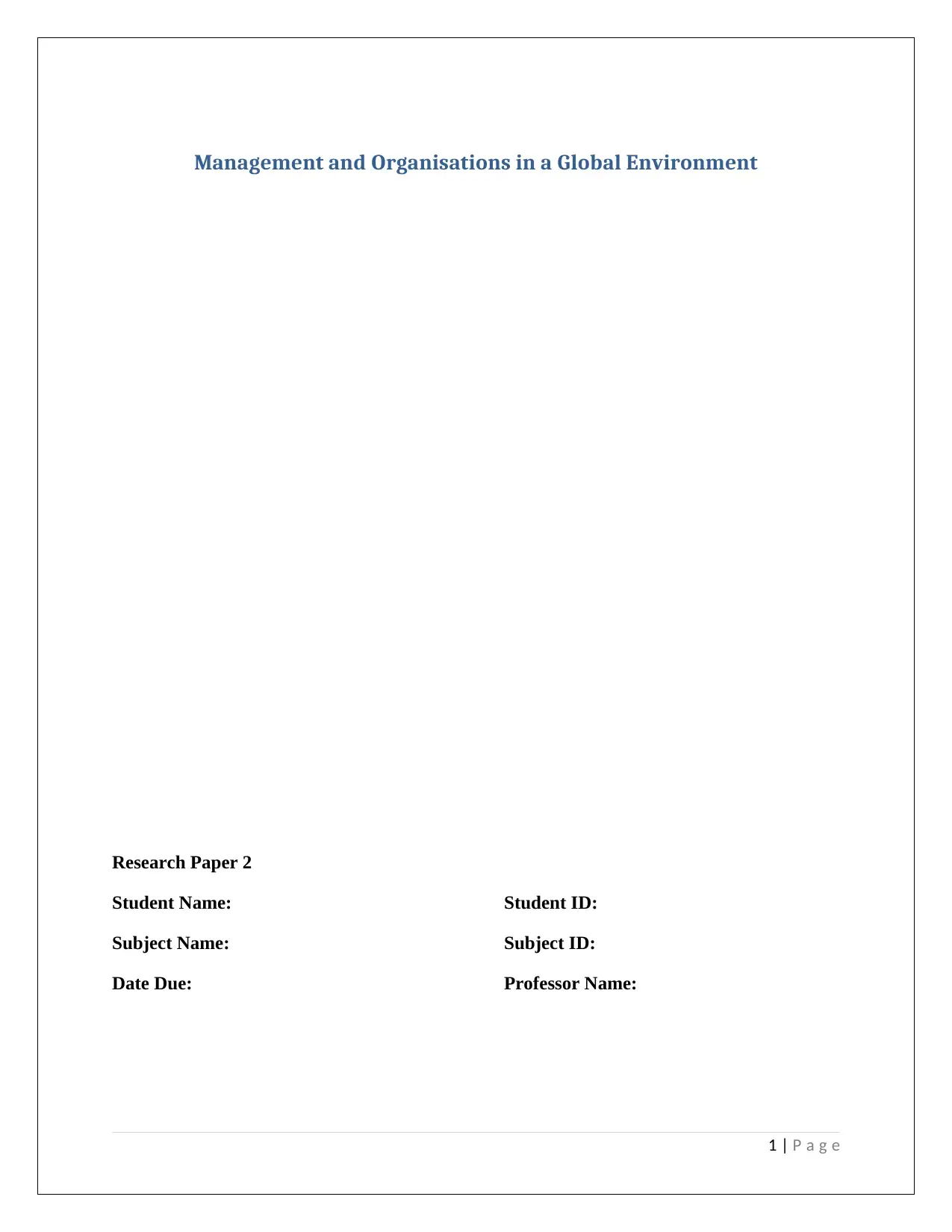
Management and Organisations in a Global Environment
Research Paper 2
Student Name: Student ID:
Subject Name: Subject ID:
Date Due: Professor Name:
1 | P a g e
Research Paper 2
Student Name: Student ID:
Subject Name: Subject ID:
Date Due: Professor Name:
1 | P a g e
Paraphrase This Document
Need a fresh take? Get an instant paraphrase of this document with our AI Paraphraser
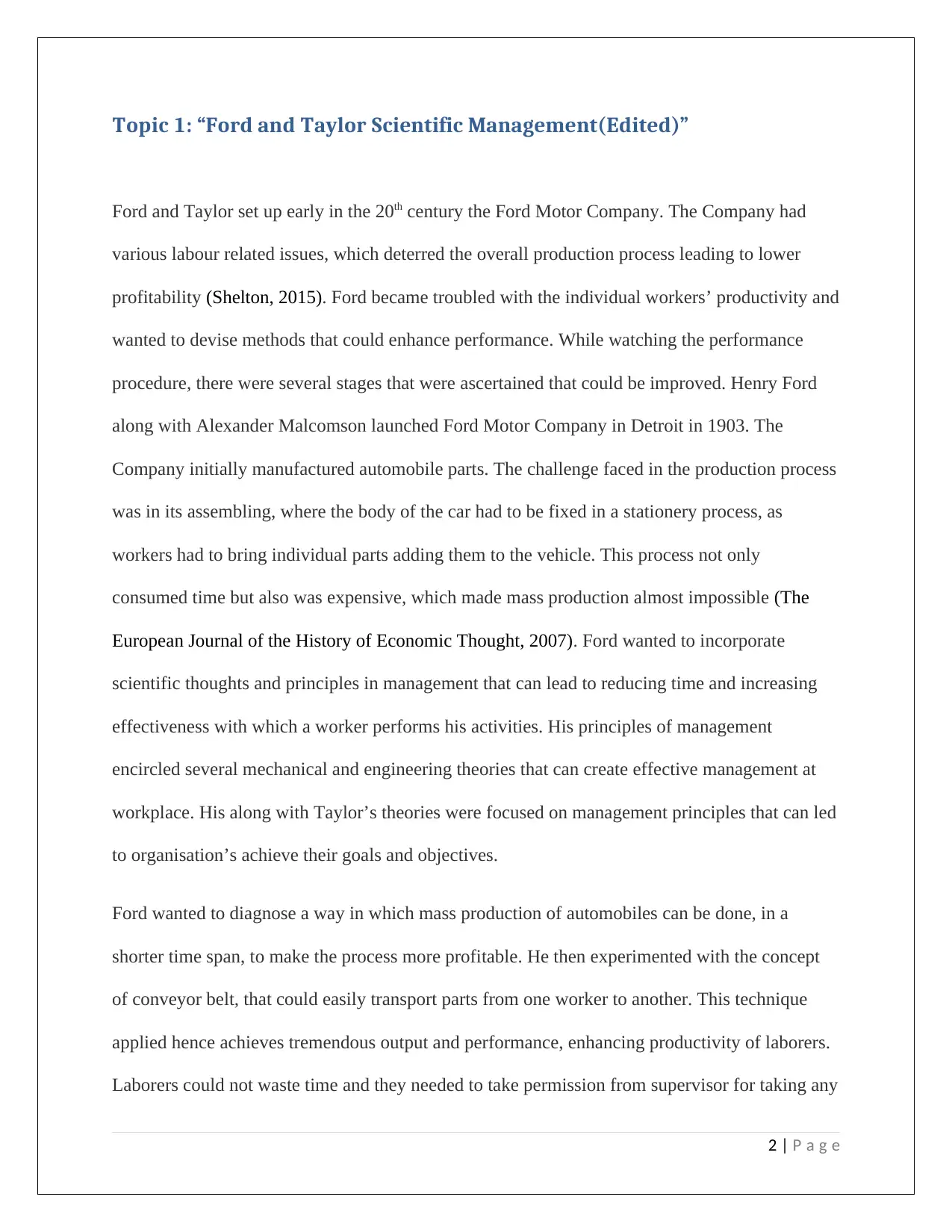
Topic 1: “Ford and Taylor Scientific Management(Edited)”
Ford and Taylor set up early in the 20th century the Ford Motor Company. The Company had
various labour related issues, which deterred the overall production process leading to lower
profitability (Shelton, 2015). Ford became troubled with the individual workers’ productivity and
wanted to devise methods that could enhance performance. While watching the performance
procedure, there were several stages that were ascertained that could be improved. Henry Ford
along with Alexander Malcomson launched Ford Motor Company in Detroit in 1903. The
Company initially manufactured automobile parts. The challenge faced in the production process
was in its assembling, where the body of the car had to be fixed in a stationery process, as
workers had to bring individual parts adding them to the vehicle. This process not only
consumed time but also was expensive, which made mass production almost impossible (The
European Journal of the History of Economic Thought, 2007). Ford wanted to incorporate
scientific thoughts and principles in management that can lead to reducing time and increasing
effectiveness with which a worker performs his activities. His principles of management
encircled several mechanical and engineering theories that can create effective management at
workplace. His along with Taylor’s theories were focused on management principles that can led
to organisation’s achieve their goals and objectives.
Ford wanted to diagnose a way in which mass production of automobiles can be done, in a
shorter time span, to make the process more profitable. He then experimented with the concept
of conveyor belt, that could easily transport parts from one worker to another. This technique
applied hence achieves tremendous output and performance, enhancing productivity of laborers.
Laborers could not waste time and they needed to take permission from supervisor for taking any
2 | P a g e
Ford and Taylor set up early in the 20th century the Ford Motor Company. The Company had
various labour related issues, which deterred the overall production process leading to lower
profitability (Shelton, 2015). Ford became troubled with the individual workers’ productivity and
wanted to devise methods that could enhance performance. While watching the performance
procedure, there were several stages that were ascertained that could be improved. Henry Ford
along with Alexander Malcomson launched Ford Motor Company in Detroit in 1903. The
Company initially manufactured automobile parts. The challenge faced in the production process
was in its assembling, where the body of the car had to be fixed in a stationery process, as
workers had to bring individual parts adding them to the vehicle. This process not only
consumed time but also was expensive, which made mass production almost impossible (The
European Journal of the History of Economic Thought, 2007). Ford wanted to incorporate
scientific thoughts and principles in management that can lead to reducing time and increasing
effectiveness with which a worker performs his activities. His principles of management
encircled several mechanical and engineering theories that can create effective management at
workplace. His along with Taylor’s theories were focused on management principles that can led
to organisation’s achieve their goals and objectives.
Ford wanted to diagnose a way in which mass production of automobiles can be done, in a
shorter time span, to make the process more profitable. He then experimented with the concept
of conveyor belt, that could easily transport parts from one worker to another. This technique
applied hence achieves tremendous output and performance, enhancing productivity of laborers.
Laborers could not waste time and they needed to take permission from supervisor for taking any
2 | P a g e
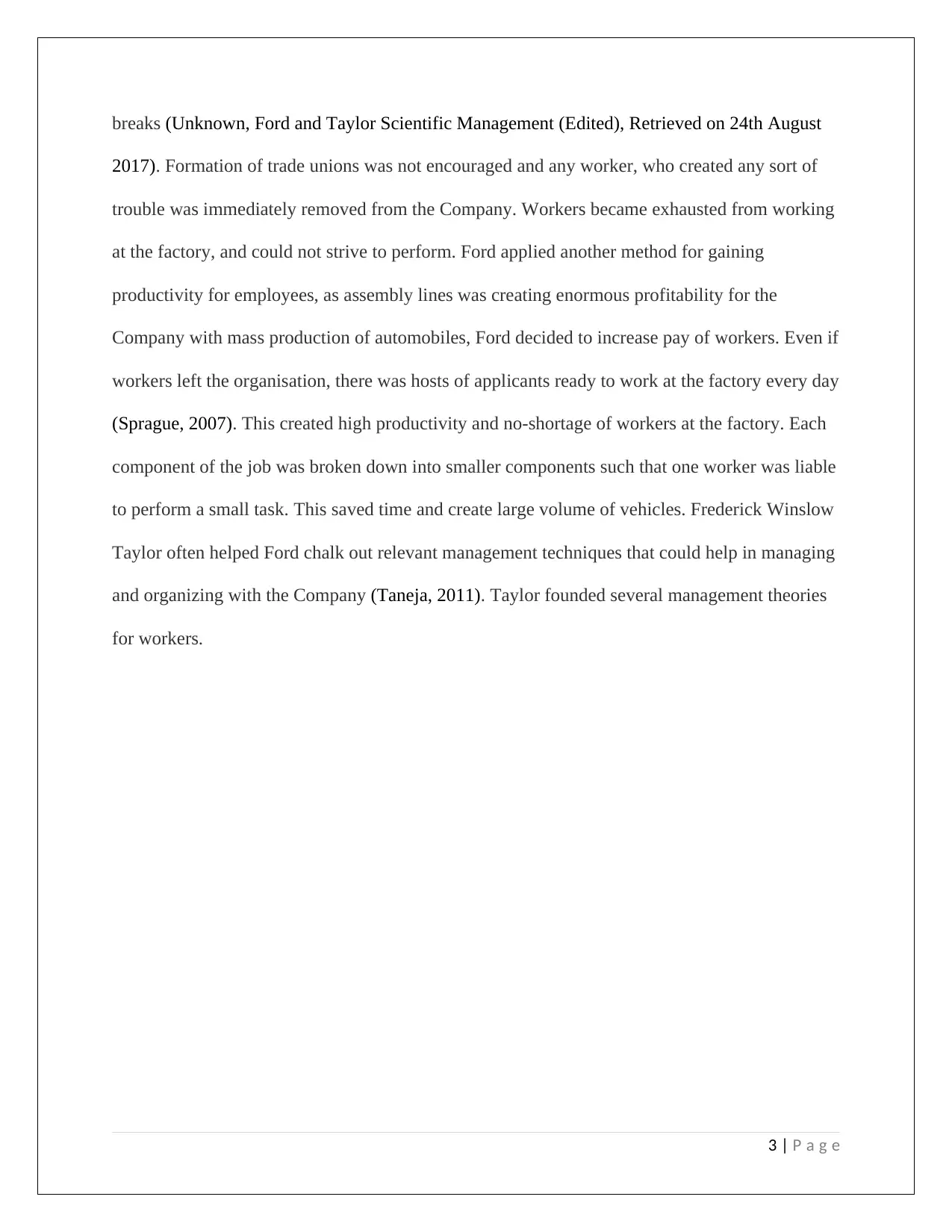
breaks (Unknown, Ford and Taylor Scientific Management (Edited), Retrieved on 24th August
2017). Formation of trade unions was not encouraged and any worker, who created any sort of
trouble was immediately removed from the Company. Workers became exhausted from working
at the factory, and could not strive to perform. Ford applied another method for gaining
productivity for employees, as assembly lines was creating enormous profitability for the
Company with mass production of automobiles, Ford decided to increase pay of workers. Even if
workers left the organisation, there was hosts of applicants ready to work at the factory every day
(Sprague, 2007). This created high productivity and no-shortage of workers at the factory. Each
component of the job was broken down into smaller components such that one worker was liable
to perform a small task. This saved time and create large volume of vehicles. Frederick Winslow
Taylor often helped Ford chalk out relevant management techniques that could help in managing
and organizing with the Company (Taneja, 2011). Taylor founded several management theories
for workers.
3 | P a g e
2017). Formation of trade unions was not encouraged and any worker, who created any sort of
trouble was immediately removed from the Company. Workers became exhausted from working
at the factory, and could not strive to perform. Ford applied another method for gaining
productivity for employees, as assembly lines was creating enormous profitability for the
Company with mass production of automobiles, Ford decided to increase pay of workers. Even if
workers left the organisation, there was hosts of applicants ready to work at the factory every day
(Sprague, 2007). This created high productivity and no-shortage of workers at the factory. Each
component of the job was broken down into smaller components such that one worker was liable
to perform a small task. This saved time and create large volume of vehicles. Frederick Winslow
Taylor often helped Ford chalk out relevant management techniques that could help in managing
and organizing with the Company (Taneja, 2011). Taylor founded several management theories
for workers.
3 | P a g e
⊘ This is a preview!⊘
Do you want full access?
Subscribe today to unlock all pages.

Trusted by 1+ million students worldwide
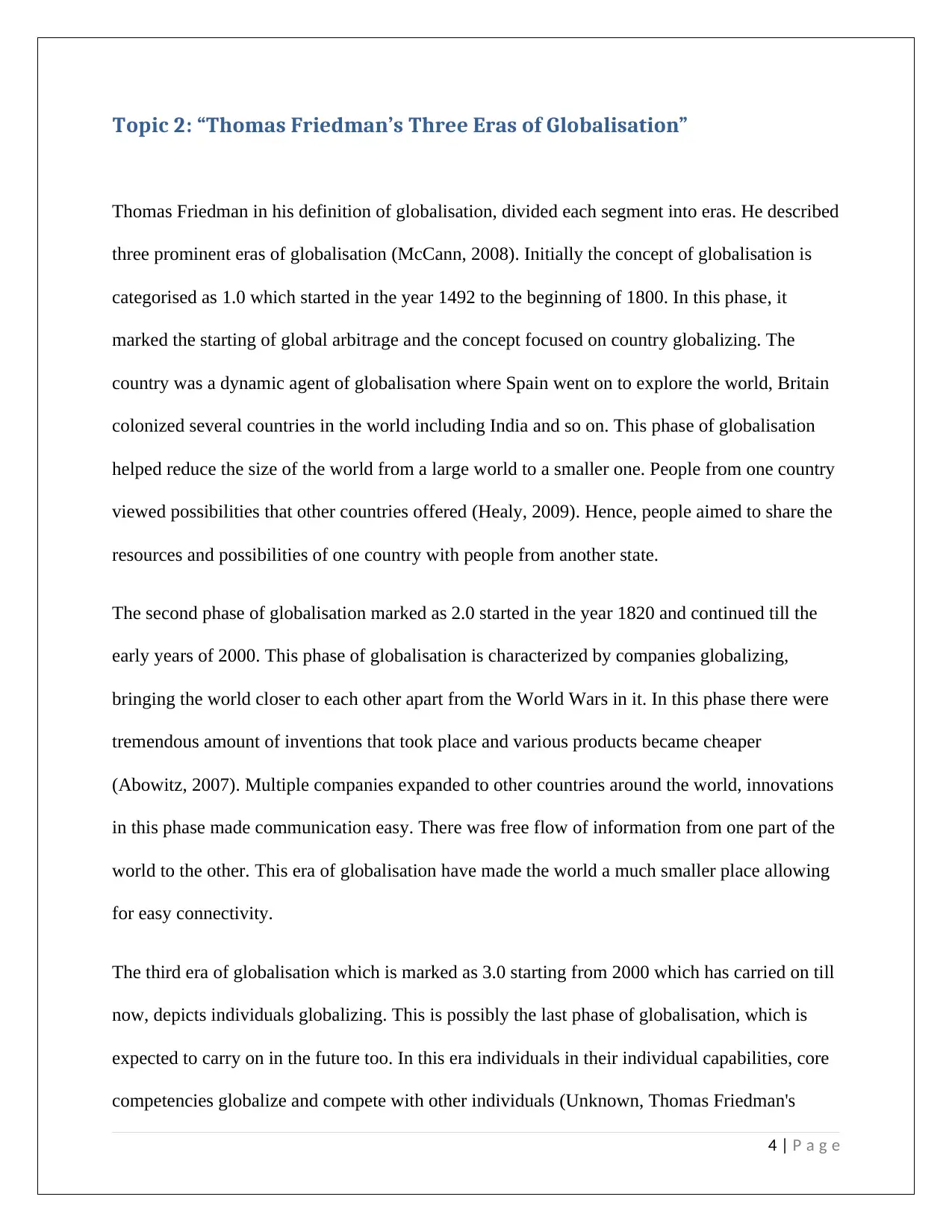
Topic 2: “Thomas Friedman’s Three Eras of Globalisation”
Thomas Friedman in his definition of globalisation, divided each segment into eras. He described
three prominent eras of globalisation (McCann, 2008). Initially the concept of globalisation is
categorised as 1.0 which started in the year 1492 to the beginning of 1800. In this phase, it
marked the starting of global arbitrage and the concept focused on country globalizing. The
country was a dynamic agent of globalisation where Spain went on to explore the world, Britain
colonized several countries in the world including India and so on. This phase of globalisation
helped reduce the size of the world from a large world to a smaller one. People from one country
viewed possibilities that other countries offered (Healy, 2009). Hence, people aimed to share the
resources and possibilities of one country with people from another state.
The second phase of globalisation marked as 2.0 started in the year 1820 and continued till the
early years of 2000. This phase of globalisation is characterized by companies globalizing,
bringing the world closer to each other apart from the World Wars in it. In this phase there were
tremendous amount of inventions that took place and various products became cheaper
(Abowitz, 2007). Multiple companies expanded to other countries around the world, innovations
in this phase made communication easy. There was free flow of information from one part of the
world to the other. This era of globalisation have made the world a much smaller place allowing
for easy connectivity.
The third era of globalisation which is marked as 3.0 starting from 2000 which has carried on till
now, depicts individuals globalizing. This is possibly the last phase of globalisation, which is
expected to carry on in the future too. In this era individuals in their individual capabilities, core
competencies globalize and compete with other individuals (Unknown, Thomas Friedman's
4 | P a g e
Thomas Friedman in his definition of globalisation, divided each segment into eras. He described
three prominent eras of globalisation (McCann, 2008). Initially the concept of globalisation is
categorised as 1.0 which started in the year 1492 to the beginning of 1800. In this phase, it
marked the starting of global arbitrage and the concept focused on country globalizing. The
country was a dynamic agent of globalisation where Spain went on to explore the world, Britain
colonized several countries in the world including India and so on. This phase of globalisation
helped reduce the size of the world from a large world to a smaller one. People from one country
viewed possibilities that other countries offered (Healy, 2009). Hence, people aimed to share the
resources and possibilities of one country with people from another state.
The second phase of globalisation marked as 2.0 started in the year 1820 and continued till the
early years of 2000. This phase of globalisation is characterized by companies globalizing,
bringing the world closer to each other apart from the World Wars in it. In this phase there were
tremendous amount of inventions that took place and various products became cheaper
(Abowitz, 2007). Multiple companies expanded to other countries around the world, innovations
in this phase made communication easy. There was free flow of information from one part of the
world to the other. This era of globalisation have made the world a much smaller place allowing
for easy connectivity.
The third era of globalisation which is marked as 3.0 starting from 2000 which has carried on till
now, depicts individuals globalizing. This is possibly the last phase of globalisation, which is
expected to carry on in the future too. In this era individuals in their individual capabilities, core
competencies globalize and compete with other individuals (Unknown, Thomas Friedman's
4 | P a g e
Paraphrase This Document
Need a fresh take? Get an instant paraphrase of this document with our AI Paraphraser
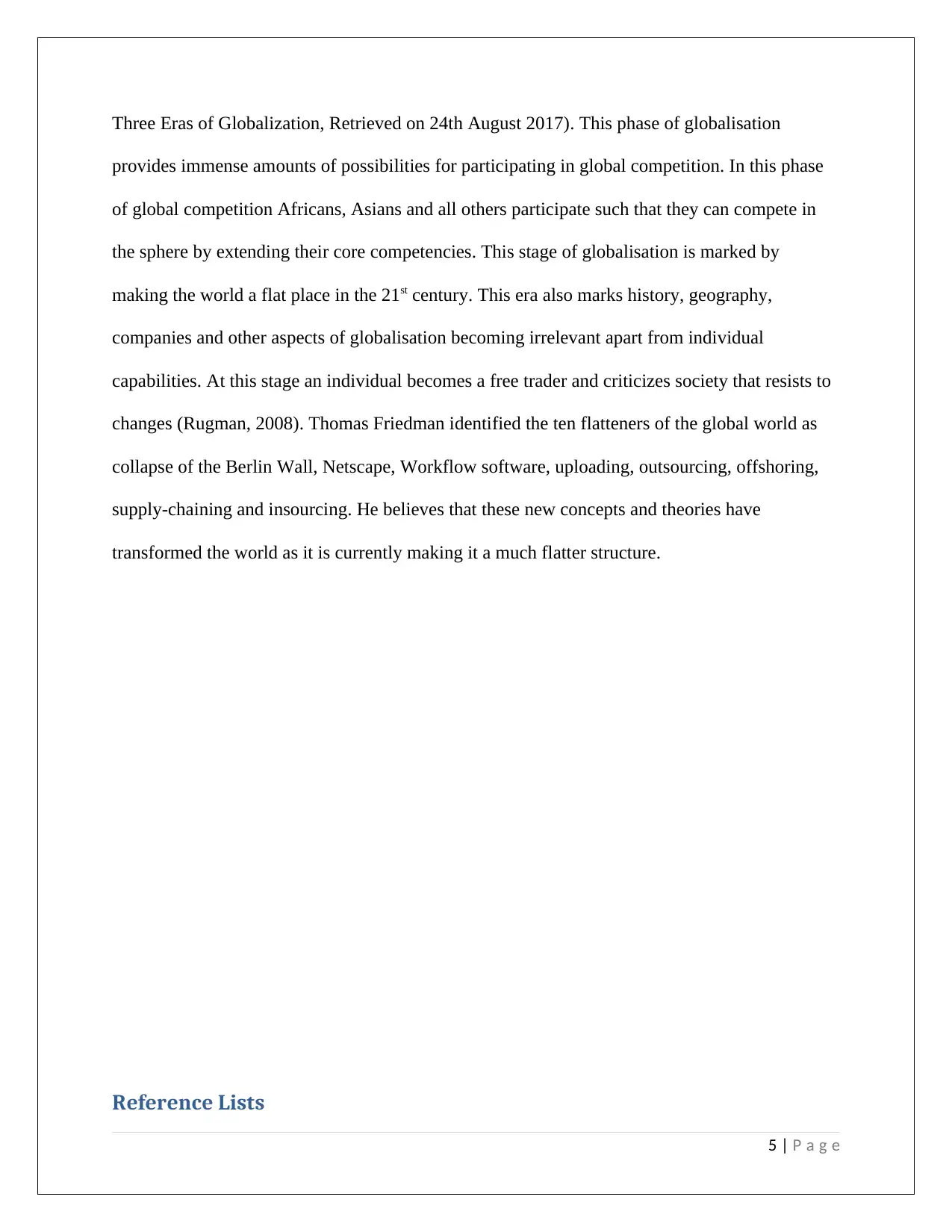
Three Eras of Globalization, Retrieved on 24th August 2017). This phase of globalisation
provides immense amounts of possibilities for participating in global competition. In this phase
of global competition Africans, Asians and all others participate such that they can compete in
the sphere by extending their core competencies. This stage of globalisation is marked by
making the world a flat place in the 21st century. This era also marks history, geography,
companies and other aspects of globalisation becoming irrelevant apart from individual
capabilities. At this stage an individual becomes a free trader and criticizes society that resists to
changes (Rugman, 2008). Thomas Friedman identified the ten flatteners of the global world as
collapse of the Berlin Wall, Netscape, Workflow software, uploading, outsourcing, offshoring,
supply-chaining and insourcing. He believes that these new concepts and theories have
transformed the world as it is currently making it a much flatter structure.
Reference Lists
5 | P a g e
provides immense amounts of possibilities for participating in global competition. In this phase
of global competition Africans, Asians and all others participate such that they can compete in
the sphere by extending their core competencies. This stage of globalisation is marked by
making the world a flat place in the 21st century. This era also marks history, geography,
companies and other aspects of globalisation becoming irrelevant apart from individual
capabilities. At this stage an individual becomes a free trader and criticizes society that resists to
changes (Rugman, 2008). Thomas Friedman identified the ten flatteners of the global world as
collapse of the Berlin Wall, Netscape, Workflow software, uploading, outsourcing, offshoring,
supply-chaining and insourcing. He believes that these new concepts and theories have
transformed the world as it is currently making it a much flatter structure.
Reference Lists
5 | P a g e
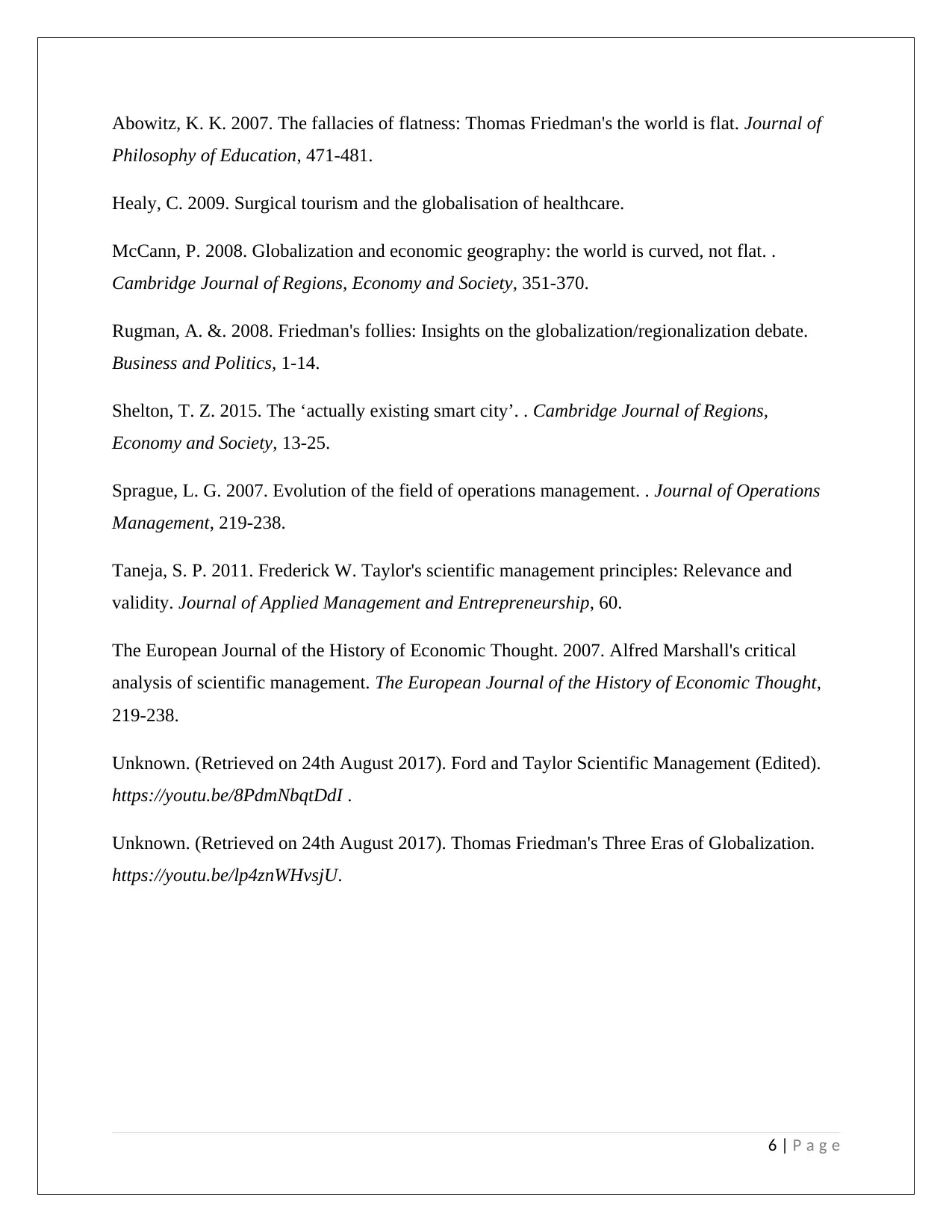
Abowitz, K. K. 2007. The fallacies of flatness: Thomas Friedman's the world is flat. Journal of
Philosophy of Education, 471-481.
Healy, C. 2009. Surgical tourism and the globalisation of healthcare.
McCann, P. 2008. Globalization and economic geography: the world is curved, not flat. .
Cambridge Journal of Regions, Economy and Society, 351-370.
Rugman, A. &. 2008. Friedman's follies: Insights on the globalization/regionalization debate.
Business and Politics, 1-14.
Shelton, T. Z. 2015. The ‘actually existing smart city’. . Cambridge Journal of Regions,
Economy and Society, 13-25.
Sprague, L. G. 2007. Evolution of the field of operations management. . Journal of Operations
Management, 219-238.
Taneja, S. P. 2011. Frederick W. Taylor's scientific management principles: Relevance and
validity. Journal of Applied Management and Entrepreneurship, 60.
The European Journal of the History of Economic Thought. 2007. Alfred Marshall's critical
analysis of scientific management. The European Journal of the History of Economic Thought,
219-238.
Unknown. (Retrieved on 24th August 2017). Ford and Taylor Scientific Management (Edited).
https://youtu.be/8PdmNbqtDdI .
Unknown. (Retrieved on 24th August 2017). Thomas Friedman's Three Eras of Globalization.
https://youtu.be/lp4znWHvsjU.
6 | P a g e
Philosophy of Education, 471-481.
Healy, C. 2009. Surgical tourism and the globalisation of healthcare.
McCann, P. 2008. Globalization and economic geography: the world is curved, not flat. .
Cambridge Journal of Regions, Economy and Society, 351-370.
Rugman, A. &. 2008. Friedman's follies: Insights on the globalization/regionalization debate.
Business and Politics, 1-14.
Shelton, T. Z. 2015. The ‘actually existing smart city’. . Cambridge Journal of Regions,
Economy and Society, 13-25.
Sprague, L. G. 2007. Evolution of the field of operations management. . Journal of Operations
Management, 219-238.
Taneja, S. P. 2011. Frederick W. Taylor's scientific management principles: Relevance and
validity. Journal of Applied Management and Entrepreneurship, 60.
The European Journal of the History of Economic Thought. 2007. Alfred Marshall's critical
analysis of scientific management. The European Journal of the History of Economic Thought,
219-238.
Unknown. (Retrieved on 24th August 2017). Ford and Taylor Scientific Management (Edited).
https://youtu.be/8PdmNbqtDdI .
Unknown. (Retrieved on 24th August 2017). Thomas Friedman's Three Eras of Globalization.
https://youtu.be/lp4znWHvsjU.
6 | P a g e
⊘ This is a preview!⊘
Do you want full access?
Subscribe today to unlock all pages.

Trusted by 1+ million students worldwide
1 out of 6
Related Documents
Your All-in-One AI-Powered Toolkit for Academic Success.
+13062052269
info@desklib.com
Available 24*7 on WhatsApp / Email
![[object Object]](/_next/static/media/star-bottom.7253800d.svg)
Unlock your academic potential
Copyright © 2020–2025 A2Z Services. All Rights Reserved. Developed and managed by ZUCOL.




